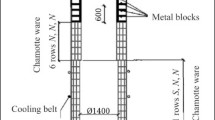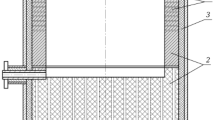A completed campaign of converter No. 2 from the firm RHI compared with a converter campaign with a traditional lining, within which the maximum life was obtained in OAO MMK, is analyzed. It is established that under conditions of charging less than 100 tons of scrap in a melt on average per campaign and observation of the procedure in the course of lining operation (delivery of MgO containing additions, observation of soaking regime after sealing, pouring and charging, skull application for more than 3 min, etc.) the life of an RHI lining is more than 6000 melts.




Similar content being viewed by others
Notes
B. M. Boichenko, V. I. Pishchida, and A. V. Karpichko, “Stage of periclase-carbon refractory wear in a converter slag belt,” Byul. Chernaya Metallurgiya, No. 8, 64 – 66 (2006).
Author information
Authors and Affiliations
Additional information
Translated from Novye Ogneupory, No. 3, pp. 103 – 105, March 2011.
Rights and permissions
About this article
Cite this article
Valuev, A.G., Govgalenko, I.V. & Afanas’ev, I.G. Experience of operating a periclase-carbon converter lining made from objects produced by RHI. Refract Ind Ceram 52, 79–81 (2011). https://doi.org/10.1007/s11148-011-9372-3
Received:
Published:
Issue Date:
DOI: https://doi.org/10.1007/s11148-011-9372-3




